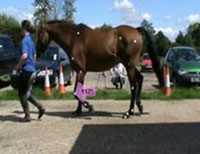Tag Archives for Equine
A preliminary study of the effect of manual chiropractic treatment on the splenius muscle in horses when measured by surface electromyography.
Evidence of a statistically significant reduction in splenius muscle activity following chiropractic treatment (McTimoney method).
Measuring muscle activity in a stabilising muscle of the spine may be a useful method of determining the effectiveness of chiropractic treatment in horses
The effects of manual chiropractic (McTimoney) and instrument assisted chiropractic on spinal mechanical nociceptive thresholds (MNTs) in flat racehorses without clinical signs.
Positive evidence that McTimoney chiropractic and instrument assisted chiropractic using an Integrator treatments on horses reduces sensitivity to pain (increased MNT’s) compared to no treatment.
McTimoney treatment appears to have a longer lasting effect (day 10) on increasing MNTs compared to treatment with the Integrator.
The effect of manual chiropractic (McTimoney) treatment on pressure measurements beneath the saddle.
Back problems in horses are recognised as an important factor in performance impairment.
Saddle fit is considered a factor in the pathogenesis of back problems.
Positive evidence that chiropractic treatment affects the horse’s back and reduces mean pressure beneath the saddle.
The effects of chiropractic treatment on the range of motion of the carpus and tarsus of horses
Clinical signs of back pain and spinal dysfunction can include asymmetric or restricted joint motion.
Positive support evidence that chiropractic treatment of horses may increase joint ROM of the carpus and tarsus and improve joint ROM asymmetry.
An investigation into the relationship of pelvic misalignment on forelimb hoof size
Pelvic rotation misalignment can be associated with reduced performance and lameness
Redistribution of locomotor forces to other limbs to off-load a limb is a compensatory mechanism
Evidence of a statistically significant relationship between the alignment of the pelvis and growth (length and width) of horse’s fore-hooves
An investigation into relationships of horse and rider pelvic asymmetry.
Assessment of single horse and rider partnerships for misalignments and asymmetry of neck, spine, pelvis
Positive evidence of a relationship between the direction of the pelvic rotation of the horse and rider pelvic tilt.
Positive basis for further research into causal effect relationships of horse and rider asymmetries.








